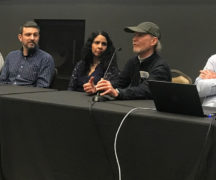From BGSU OFFICE OF MARKETING & BRAND STRATEGY
Groundbreaking research at Bowling Green State University is transforming traditional views of farming while paving the way for a more sustainable and environmentally friendly future.
Dr. Kevin Neves, associate teaching professor of biology, and graduate student Maria D’Amico ’22 are using aquaponics—a sustainable farming method that combines aquaculture and hydroponics—to raise Lake Erie fish and crops, like lettuce and tomatoes, at the same time.
The method harnesses the symbiotic relationship between aquatic animals and plants, creating a closed-loop system where fish waste serves as a nutrient source for plant growth, while the plants act as natural filters, purifying the water for the fish.
Their work has garnered attention beyond the academic realm, with PBS expressing interest in featuring their research in the documentary series “America the Bountiful,” set to air in early 2025.
Housed inside the BGSU Greenhouse, the setup involves three large tanks – two are filled with yellow perch and one is filled with crayfish. Water from the tanks flows into a 5-by-20-foot trough that supports plants – tomatoes and lettuce – on floating panels, with their roots submerged underwater.
An important feature of the closed system is that it results in no nutrient runoff as water is filtered and recirculated. The benefit is there is no risk of nutrients entering surface water and potentially contributing to the growth of harmful algal blooms in a watershed.
“Our integrated multi-trophic aquaponics system represents a novel approach to sustainable agriculture,” Neves said. “By harnessing the natural processes of aquatic ecosystems, we’re able to produce food in a way that minimizes environmental impact and maximizes efficiency.”
An additional benefit of the system is the volume of food that can be produced. In a span of six months, the pilot program produced 200 pounds of tomatoes and about 50-100 pounds of yellow perch.

“Aquaponics offers a unique opportunity to address environmental challenges, such as water scarcity and pollution,” said D’Amico who hails from Cleveland. “Through our research, we’re not only finding innovative ways to grow food but also contributing to the preservation of freshwater ecosystems.”
The aquaponics system developed at BGSU utilizes freshwater fish and crayfish to help grow plants in a mutually beneficial relationship. Fish waste is converted into nutrients by the crayfish, which is then used to fertilize the tomato and lettuce plants. This integrated approach maximizes resource utilization and minimizes waste production, making it a truly sustainable farming method.
“Aquaponics addresses several significant problems. It provides a sustainable source of food production,” Neves said. “The system is designed to be as natural as possible, without relying on fertilizers or pesticides, using only tap water.”
What sets Neves and D’Amico’s research apart is its scalability and adaptability. Their system can be implemented in various settings, from urban environments to rural communities, offering a viable solution to food production challenges faced worldwide.
“We envision a future where aquaponics plays a central role in sustainable agriculture,” Neves said. “By harnessing the power of nature, we can create a more resilient and efficient food system that benefits both people and the planet.”
As D’Amico reflected on her educational journey, she emphasized the importance of the hands-on, experiential learning and mentorship she has experienced at BGSU.
“BGSU has provided invaluable opportunities to explore my passion for freshwater ecology and aquaponics. Working alongside Dr. Neves and being part of the aquaponics research team has been a transformative experience, shaping my career path and fueling my commitment to environmental conservation,” she said,



